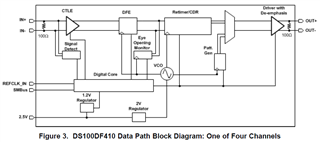Other Parts Discussed in Thread: DS100DF410, TLK10031, , DS110DF111
I am looking for an IC to use in a 10G Ethernet application to convert a 10GBASE-KR (backplane) interface from a CPU board to into 10BASE-SR interface from an SFP transceiver. I've seen a design that uses one of TI's 10G Ethernet Retimers (DS100DF410 or DS125DF111) for this purpose. But I've researched TI's 10G Ethernet transceivers (TLK10031, for example) that seems to be used for the same purpose. What are the advantages and disadvantages of using one of these Retimers over using one of these transceivers for this application?



